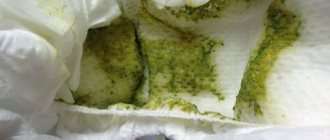In young children, gagging can occur independently under the influence of various factors . This condition can be triggered by overeating, food or drug poisoning, intestinal infection and severe stress. But it happens that you urgently need to clear the child’s stomach of dangerous contents by artificially inducing vomiting. Not all parents know how to do this correctly, so precious minutes are often lost. So how to induce vomiting in a child in order to clear the stomach and not harm the baby? There are several effective ways to help with this.
What types of vomiting are there?
Vomiting is not a disease, but a symptom that is caused by one reason or another. It occurs when the body tries to get rid of harmful substances. The loss of fluid that occurs at this time is difficult for adults to bear. What can we say about the children's body, which is more sensitive to various painful manifestations. Dehydration can have serious consequences. That's why it's important to know how to stop vomiting at home quickly. This does not mean that further consultation with a doctor is canceled. But timely assistance plays an important role.
There are the following types of vomiting:
- vomiting with mucus,
- vomiting with bile,
- vomiting blood.
Each of them occurs for different reasons. To understand how dangerous this is for a child’s health, you need to understand the nature of each type.
Vomiting with mucus occurs in the following cases:
- when overeating in infants (there is nothing to worry about in the presence of mucus, since it can get there from the bronchi or nasopharynx),
- as a sign of food poisoning,
- with exacerbation of chronic gastritis,
- for inflammation of the stomach, which is caused by irritating substances such as drugs,
- during a viral infection,
- for disorders in the central nervous system.
Vomiting with bile, which may have a yellow or greenish tint in a child, is caused by the following factors:
- fatty, spicy, fried foods,
- binge eating,
- food poisoning.
Bloody vomiting occurs due to the following diseases:
- stomach ulcer,
- duodenal erosion,
- mushroom poisoning,
- poisoning,
- entry of foreign bodies into the gastrointestinal tract.
If blood in the vomit occurs in infants, this may indicate that it entered the stomach from the mother's nipples during breastfeeding.
In other cases, bloody vomiting is a very dangerous symptom. It cannot be treated at home so as not to harm the child. You should consult a doctor as soon as possible!
Bloody vomiting indicates that bleeding has appeared in the digestive tract. If the blood comes from the upper part of the stomach, esophagus, pharynx or oral cavity, then it is characterized by a scarlet color. The dark color of the blood means that its source is the stomach or duodenum.
The reasons why the gag reflex occurs in infants and older children differ. Let's take a closer look at each of the categories.
Prevention
Preventive measures consist of simple hygiene, quality products, properly prepared food.
Helps prevent vomiting:
- Treatment of diseases, prevention of complications;
- Immunoprophylaxis;
- Maintaining hygiene;
- Fresh food;
- Keep your child away from chemicals;
- Dosage medications correctly and keep them away from children.
All parents have experienced child vomiting and know how difficult it is not to panic at this moment, but it is calm that your baby needs.
If the unpleasant syndrome is one-time, it is known what provoked it, there are no dangerous symptoms, you can wait to call the doctor. In all other cases, contacting a doctor is mandatory. Self-medication is dangerous for the child’s life. Rate this article:
Where does vomiting in infants come from?
Infants may suffer from vomiting due to the following factors:
- Binge eating.
- Airbrush. This is the name for air entering the baby’s stomach when improper breastfeeding occurs. This leads not only to a gag reflex, but also to bloating.
- Motion sickness. If you overdo it with rocking the baby, he may vomit.
- Unformed functioning of the gastrointestinal system. Before one year of age, some children experience a phenomenon where food from the stomach again enters the esophagus, which leads to vomiting.
- Pilostenosis. This serious disease occurs due to the fact that food does not pass into the intestines. This leads to vomiting and thinness of the baby.
- Teething.
- Colds. High temperature also provokes the gag reflex. Sometimes a lot of mucus enters the esophagus, which is characteristic of a respiratory tract disease, which leads to vomiting.
- Coughing. Tension in the abdominal muscles can cause vomiting.
- Heart and liver problems. In acute heart failure and liver disease, the child has no appetite. Therefore, he reacts to food by vomiting.
Some of the reasons listed require immediate medical attention. If you suspect a cold, polystenosis, or heart and liver disease, be sure to consult a doctor.
Surgical diseases
Acute appendicitis is a surgical emergency in which inflammation occurs in the cecum. In this case, vomiting in children under 3 years of age becomes one of the signs of pathology, since due to their age they cannot indicate the exact symptoms of appendicitis. Read more about acute appendicitis →
Vomiting can become frequent with accompanying headache and increased body temperature: in children under one and a half years old, its levels can reach 38 degrees, in older children it can remain low-grade.
A characteristic sign of appendicitis, pain in the right side, may be absent in childhood. Most often, the child points to the navel area. Very young children who cannot yet speak react to acute appendicitis with loss of appetite and sleep, repeated vomiting, and extreme anxiety.
Intussusception is a pathological condition characteristic of children 6-12 months old, less often up to 2 years old. With this disease, one section of the intestine is embedded in another, causing disruption of the functional activity of the intestine.
The causes of this disease have not been studied. In infants, predisposing factors to the development of intestinal intussusception is the illiterate introduction of complementary foods; in children older than one year, the pathology can be caused by intestinal malformations or the presence of polyps, worms, etc.
Clinical symptoms of intussusception are cramping pain in the abdominal area, which becomes more frequent as the pathological process develops. Small children under one and a half years old twist their legs and press them to their stomach during the next attack of pain. All this happens against the background of increased anxiety in the child.
Abdominal pain is soon accompanied by vomiting and weakness, fever with headache. Bile can be found in the contents of vomit. If the child does not receive immediate medical and surgical care, the stool becomes crimson in color due to the presence of blood in it. An urgent, life-threatening condition for children develops. Urgent consultation with a surgeon is necessary.
What Causes Vomiting in Older Children
There are many reasons for infant vomiting:
- overvoltage,
- panic fear,
- concussion,
- poisoning with toxic substances,
- Strong headache,
- meningitis,
- allergy,
- viral diseases,
- infectious diseases of the gastrointestinal system (acute appendicitis, dysentery, salmonellosis, gastroenteritis and others),
- non-infectious diseases of the gastrointestinal tract (stomach ulcer, gastritis and others),
- acute renal failure,
- diabetes.
Neurological disorders
The gag reflex, which is provoked by neurological abnormalities, is otherwise called cerebral. There can be a huge number of reasons for this manifestation. They can be either congenital or acquired; it is worth considering the main varieties:
✚
Fetal hypoxia.
Otherwise referred to as intrauterine development. The disease is associated with asphyxia during prolonged labor. ✚
Postpartum trauma.
✚
Pathology of the central nervous system. The disorder is associated with the nervous system and certain endings.
✚
Traumatic brain injury. The most common types of concussions occur.
✚
Meningitis. This disease is associated with inflammation in the meninges.
✚
Tumor. It can be either benign or malignant.
✚
Migraine.
✚
Epilepsy.
The disease is associated with seizures, which occur rarely. A cerebral gag reflex can occur in a baby out of the blue. It is accompanied by severe pain in the head, constant nausea, the skin becomes pale and covered with cold sweat, dizziness of varying degrees appears, which can lead to fainting.
To call or not to call a doctor?
How to figure out whether to call an ambulance or treat your child at home? Children often experience vomiting, which does not indicate serious health problems. Then parents can cope without hospitalization. But there are symptoms, when they appear, you need to consult a doctor.
Call an ambulance if vomiting is accompanied by the following symptoms:
- diarrhea,
- blood in vomit,
- greenish tint of vomit,
- strong foul odor of vomit,
- heat,
- convulsions,
- loss of consciousness.
If vomiting occurs more than three times in two hours, this is already a reason to seek medical help.
How to deal with the gag reflex
To restore the water-electrolyte balance, disturbed by frequent vomiting, the child is given plenty of fluids to drink. The water is given slightly warm. Compotes, juices and soda are contraindicated in this case. If the baby refuses water, it can be replaced with a decoction of rose hips, chamomile, St. John's wort or sweetened tea.
Children under 1 year of age should be given about 70 ml of liquid after each vomiting. For babies older than one year, the dosage is increased to 100 - 150 ml. You should not force the baby to drink. Signs such as:
- lethargy;
- dry skin;
- irritability;
- retraction of the fontanel;
- drying of the mucous membrane of the lips;
- lack of urination for 3 to 4 hours.
What to do if your child is vomiting
While the doctor is on the way, you need to take the following first aid measures:
- Place the child on his side to prevent vomit from entering the respiratory tract. The baby can be held upright.
- To avoid fluid loss, give the patient more water. Use boiled or mineral water. It is advisable to consume it every five minutes in small sips. For the little ones, you can use a teaspoon or pipette.
- Do not eat food while vomiting.
- Do not take medications before consulting a doctor.
- It will not be superfluous to rinse your mouth and wash your face after each attack. Vomit, getting on the skin and mucous membranes, can cause irritation.
- If bloody vomiting occurs, place ice on the child's stomach. This will help reduce bleeding. You can also let your child swallow a piece of ice.
An emergency medical technician or pediatrician you contact should perform an examination to determine the cause of your gag reflex. Treatment is prescribed according to this. The doctor may recommend what to give your child for vomiting. Typically, such drugs act in four ways:
- to stop the gag reflex,
- sorbents for neutralizing toxins,
- antiviral and antimicrobial drugs,
- painkillers.
The main thing is not to resort to medication without finding out the cause of vomiting, since different diseases are treated with different drugs. For example, in case of poisoning, antiviral agents should not be used.
It is not recommended to take anything to stop the gag reflex until the toxic substances have left the body.
What not to do
Of course, during illness the child needs additional care. But here it is important not to overdo it.
- to force the baby to eat until the period of recovery begins; it will be enough to give liquid porridge and warm milk;
- Do not bathe your child if the temperature does not exceed 37.2 °C. Thanks to water procedures, the body warms up and removes excess toxins. It is recommended to add herbal infusions and essential oils in small quantities to the water;
- wrap the child, especially if the temperature is elevated;
- do not take walks in the fresh air. If the weather is appropriate, then you definitely need to be outside.
Traditional medicine against vomiting
Antiemetics can also be prepared at home. Traditional medicine will come to the rescue. Such remedies have a gentler effect on the child’s body, having an effective effect on symptoms. Although in this case, do not be too lazy to consult a doctor.
When a child starts vomiting, you can prepare the following remedies:
- Brew green tea. Add honey or sugar for taste.
- Make dill water. Use one teaspoon of dill fruit for a glass of boiling water. You need to cook in a water bath. After cooking, give a teaspoon.
- Grate the quince and serve in small portions. It can also be baked in the oven.
- Vomiting with bile is stopped with this remedy: pour two tablespoons of peppermint leaves into a glass of boiling water. Let it brew for two hours and give your child a tablespoon five times a day.
Various infusions are also used: infusion of valerian or lemon zest, ginger infusion. Potato juice or asparagus powder is used against vomiting.
What to do to speed up your child’s recovery
When the nausea has stopped, let the baby sleep. Do not rush to feed him, as the body must gradually recover. It is best to wait until the child asks to eat. It is not recommended to feed the child for the first twelve hours after vomiting stops.
Even after the vomiting has stopped, it is important to take care of the child’s weakened health. Therefore, do not give him fried, salty, spicy, fatty or smoked foods. Also, at first, avoid fruits and vegetables that irritate the intestinal and stomach mucosa. Chicken broth and mucus soups are the best food for someone who is suffering from vomiting. Herbal teas and jelly are suitable. Food must be clean to avoid infection.
Make sure that the child does not overexert himself during the recovery period. He must get plenty of rest.
Conclusion
The causes of vomiting are different. They differ depending on the age of the child. The correct methods of helping a baby who has started vomiting will relieve health complications. It is important for parents not to panic, but to immediately resort to competent measures. And let the little family members never get sick!
- Author: Elena
Rate this article:
- 5
- 4
- 3
- 2
- 1
(0 votes, average: 0 out of 5)
Share with your friends!
Reviews from parents
Tatyana, 28 years old, Samara
The child is 7 years old. For severe coughing attacks accompanied by vomiting, a nebulizer helps us a lot. We breathe every hour until the cough stops.
For the solution, I dilute the Furacilin tablet in half a glass of water. Within 2 days of such procedures, the cough completely disappears.
Valentina, 25 years old, Kaluga
Many people advise not to panic. But how can you remain calm in this case? We once had such a problem with a 3-year-old child. The doctor prescribed alkaline drinking and antihistamines.
During treatment, a lot of sputum came out. It’s good that treatment started on time. As the doctor said, if we had delayed it, we could not have avoided even bigger problems.
Anna, 36 years old, Bryansk
If you have a severe cough, and even with vomiting, you should immediately and without hesitation call a doctor. This condition is very serious for a child, especially if he is still very young and cannot cope with the cough on his own.
Excess mucus can cause pneumonia in a fairly short period of time.











